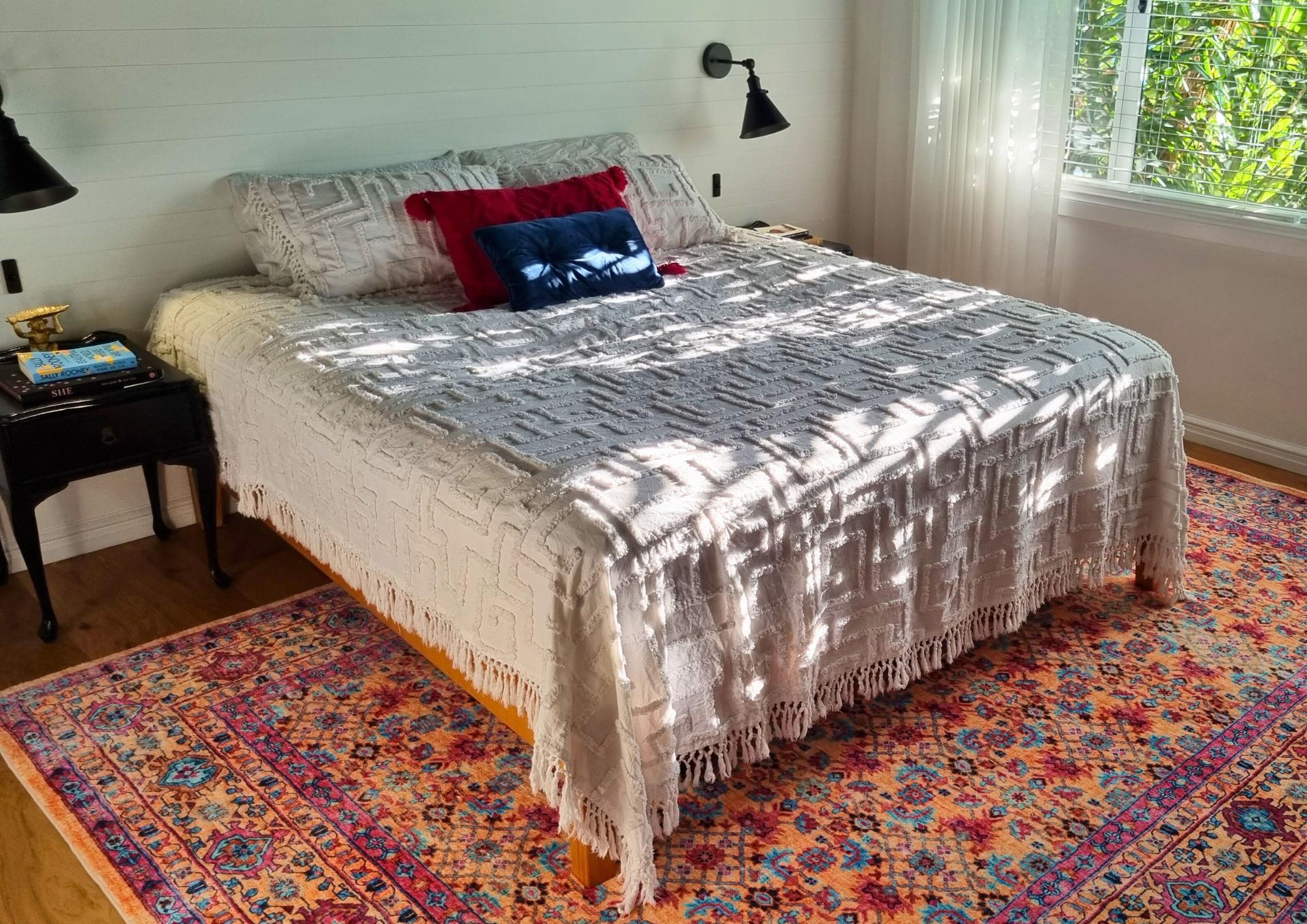
What Is Batik Fabric? Everything You Need To Know
What is Batik fabric? Pronounced 'bə-ˈtēk' in English, it’s an artistic textile that weaves together cultural heritage, intricate designs, and vibrant colours. Here, we’ll talk about its origins and significance, tracing its roots to ancient Indonesian civilisations.
We’ll cover the diverse styles and techniques within batik, from traditional motifs inspired by nature to contemporary interpretations blending modern influences. Moreover, we’ll delve into the meticulous creation process, exploring the traditional wax-resist dyeing technique and essential tools.
You’ll find yourself pleasantly surprised with the versatility of batik in fashion, home decor, rug options, and contemporary art. Keep reading to learn how to care for and preserve batik fabric, ensuring its beauty for future generations.
Defining Batik Fabric: Exploring the Artistic Textile
What is batik? Batik fabric, a true masterpiece in the world of textiles, unveils a mesmerising art form that captivates with its intricate designs and vibrant colours. Derived from the Javanese word ‘ambatik’ meaning ‘a cloth with little dots’, batik fabric showcases the art of drawing and painting on cloth.
The process involves applying hot wax to specific areas of the fabric, forming a barrier against dyes, and creating distinct patterns upon dyeing. This meticulous technique passed down through generations, showcases the remarkable craftsmanship and attention to detail that define batik fabric.
Cultural Heritage: Tracing the Origins and Significance
Batik fabric is steeped in rich cultural heritage, its origins dating back centuries. This captivating art form finds its roots in the ancient civilisations of Indonesia, particularly in Java, where it holds profound cultural significance.
Batik designs often narrate stories, legends, or symbols that represent the traditions and beliefs of the community. They are a celebration of cultural identity and a visual language passed down from one generation to the next.
Diversity of Batik Fabrics: Exploring Different Styles and Techniques
The diversity of batik fabric is a testament to its enduring appeal and artistic versatility.
Traditional batik features intricate motifs inspired by nature, mythology, and folklore. Meanwhile, contemporary interpretations embrace modern influences, blending traditional designs with contemporary aesthetics. Additionally, the technique used to create batik fabric can vary, ranging from hand-drawn designs with a canting tool to block printing, where stamps are used to apply wax.
💡KEY TAKEAWAY: Batik fabric, an extraordinary artistic textile, encompasses a rich heritage, cultural significance, and a wide range of styles and techniques. Its intricate designs and vibrant colours showcase the impeccable craftsmanship passed down through generations.
The Creation Process of Batik Fabric
Traditional Batik Technique: A Closer Look at Wax-Resist Dyeing
To truly appreciate the artistry behind batik fabric, it is essential to delve into the traditional technique of wax-resist dyeing. This time-honoured method involves applying melted wax to selected areas of the fabric, creating a protective barrier against dyes.
The waxed areas remain undyed, preserving the original colour or creating intricate patterns. Once the wax has dried, the fabric is submerged in a dye bath, where the desired hue permeates the exposed areas. The process is repeated, layer upon layer, to achieve the desired design complexity and colour depth. Finally, the wax is removed, unveiling the masterpiece of batik fabric.
Tools and Materials: Essential Supplies for Batik Making
To embark on your own batik-making journey, you will need a set of indispensable tools and materials. A tjanting, a small, metal tool with a spout, is used to apply the hot wax onto the fabric. It allows for precise control, enabling the artist to create intricate lines and shapes. A canting, a similar tool with a wooden handle and copper reservoir, is an alternative option for applying wax.
Additionally, you will require a sturdy frame to stretch the fabric taut during the wax application and dyeing process. Natural dyes, such as indigo, are often used to achieve authentic colours, while synthetic dyes offer a wider range of hues. Finally, a fabric or cloth made of natural fibres, such as cotton or silk, is preferred for its ability to absorb dyes effectively.
Step-by-Step Process: From Designing to Dyeing Batik Fabric
Designing and dyeing batik fabric involves a series of meticulous steps. First, you conceptualise your design, either by drawing it directly onto the fabric or by transferring a pre-drawn design using carbon paper. Next, you apply wax to the areas that should remain undyed, utilising the tjanting or canting tool. The wax must cool and harden before proceeding to the dyeing stage.
Prepare your chosen dyes according to the manufacturer's instructions and submerge the fabric, allowing it to absorb vibrant hues. Rinse and dry the fabric before repeating the wax application and dyeing process for subsequent layers. The final step involves removing the wax by either boiling the fabric or ironing it between layers of absorbent paper.
The result is a stunning batik fabric, with intricate patterns and vibrant colours that showcase the skill and dedication of the artist.
💡KEY TAKEAWAY: The creation process of batik fabric involves the traditional technique of wax-resist dyeing, where melted wax is applied to select areas of the fabric as a protective barrier. Essential tools include a tjanting or canting tool, a sturdy frame, natural or synthetic dyes, and fabric made of natural fibres. The step-by-step process includes designing, wax application, dyeing, and wax removal.
Distinctive Features and Characteristics of Batik Fabric
Intricate Designs and Patterns: Symbolism and Cultural Motifs
One of the most captivating aspects of batik fabric lies in its intricate designs and patterns, each telling a unique story and reflecting cultural motifs and symbolism. The artistry of batik is steeped in symbolism, with patterns often representing specific meanings, traditions, or events.
Floral motifs, for example, symbolise beauty and fertility, while geometric patterns may convey spiritual beliefs or offer protection against negative forces. Animals, such as birds and fish, can be found in batik designs, embodying various qualities like grace, abundance, or resilience.
Each design element carries a deeper significance, allowing batik fabric to not only adorn but also communicate and preserve cultural narratives.
Vibrant Colours and Dyeing Techniques: Exploring Traditional Methods
Batik fabric is renowned for its vibrant and eye-catching colours, achieved through a range of traditional dyeing techniques. Natural dyes derived from plants, roots, and barks are often used to achieve authentic hues. Indigo, obtained from the leaves of the Indigofera Tinctoria plant, creates stunning shades of blue, while soga brown comes from the mangrove tree's bark, imparting warm earthy tones.
The dyeing process itself is an art form, with techniques such as dip dyeing, immersion dyeing, and hand painting being employed to achieve various effects and colour combinations. Layer upon layer of dye is meticulously applied, resulting in an interplay of colours that bring batik fabric to life.
Texture and Fabric Quality: Understanding the Materiality of Batik
The texture and fabric quality of batik play a significant role in its appeal and longevity. Batik fabric is traditionally made from natural fibres, such as cotton or silk, which lend it a soft and luxurious feel.
The fabric is carefully selected for its ability to absorb dyes and showcase intricate details. The process of applying wax and dyes can result in slight variations in texture, adding depth and dimension to the fabric. The tightness of the weave and the quality of the fibres used contribute to the overall durability and longevity of batik fabric, ensuring that it can be enjoyed and cherished for generations to come.
💡KEY TAKEAWAY: Batik fabric is characterised by its intricate designs, vibrant colours, and exquisite texture. The use of traditional dyeing techniques and natural dyes results in a mesmerising array of colours that bring the fabric to life. The texture and fabric quality of batik, often made from natural fibres, add to its appeal and durability.
Versatility and Applications of Batik Fabric
Traditional Garments and Accessories: Batik in Fashion
Batik fabric finds its place of honour in the realm of fashion, gracing traditional garments and accessories with its vibrant colours and intricate patterns. Traditional batik clothing, such as sarongs, kebayas, and baju kurungs, not only exemplify cultural identity but also showcase the artistry and craftsmanship inherent in batik.
These garments are often worn for special occasions, celebrating the rich heritage and customs of the communities that create them. Batik has also gained popularity in contemporary fashion, with designers incorporating batik fabric into modern silhouettes and accessories. From dresses and blouses to scarves and handbags, batik adds a touch of elegance and individuality to your wardrobe.
Home Decor and Furnishings: Incorporating Batik into Interiors
Batik fabric is a powerful tool for transforming your living spaces into havens of beauty and cultural richness. When used in home decor and furnishings, batik brings a sense of warmth, tradition, and artistry to your surroundings.
Incorporate batik pillows, throws, or table runners into your interiors to infuse a touch of colour and pattern. Adorn your walls with batik tapestries or frame small pieces of batik fabric as art. Batik curtains or blinds can add a touch of elegance and uniqueness to your windows. From bedding to upholstery, batik offers endless possibilities for creating a space that is both visually striking and deeply meaningful.
Contemporary Art and Innovative Uses: Exploring Batik Beyond Tradition
Batik fabric has transcended its traditional roots and entered the realm of contemporary art, inspiring artists to push boundaries and explore innovative applications. From mixed-media installations to avant-garde fashion pieces, batik fabric has become a medium for artistic expression.
Artists experiment with unconventional materials, combine batik with other art forms, and use batik fabric as a canvas for painting or embroidery. This evolution expands the horizons of batik, breathing new life into this ancient art form while honouring its cultural heritage.
💡KEY TAKEAWAY: Batik fabric's versatility knows no bounds, as it finds its place in fashion, home decor, and contemporary art. Batik's journey into the realm of contemporary art showcases its adaptability and inspires innovation.
Care and Maintenance of Batik Fabric
Washing and Cleaning Tips: Preserving the colours and Designs
To ensure the longevity of your beloved batik fabric, it is crucial to handle its washing and cleaning with utmost care. When washing batik, always opt for gentle detergents specifically formulated for delicate fabrics. Handwashing is typically recommended to avoid any damage. Use lukewarm water and a mild detergent, gently agitating the fabric without rubbing or wringing it.
Rinse thoroughly until the water runs clear, ensuring no detergent residue remains. Avoid exposing batik fabric to direct sunlight while drying, as it may cause fading. Instead, lay it flat on a clean, absorbent towel, gently patting it to remove excess moisture. Iron batik fabric on the reverse side while it is still slightly damp, using a low to medium heat setting.
This approach helps to preserve the vibrancy of the colours and the intricate details of the designs.
Handling and Storing Batik Fabric: Ensuring Longevity
Proper handling and storage play a crucial role in preserving the beauty and longevity of batik fabric. When handling batik, always ensure clean, dry hands to prevent any transfer of dirt or oils onto the fabric. Avoid folding batik fabric along the same lines repeatedly to minimise creasing. Instead, gently roll the fabric with acid-free tissue paper, preserving its smoothness and preventing any permanent creases.
To protect batik fabric from dust and light exposure, store it in a cool, dry, and dark environment. Acid-free tissue paper or cotton fabric can be used to wrap the fabric before placing it in a storage box or a breathable fabric bag. Regularly check on the fabric to prevent any moisture buildup or potential damage.
Preservation Techniques: Maintaining the Beauty of Batik for Future Generations
Preserving the beauty of batik for future generations involves implementing specific techniques. Limit the exposure of batik fabric to direct sunlight, as prolonged exposure can cause fading. Avoid storing batik in high-humidity areas or places prone to temperature fluctuations, as these conditions can promote mould or mildew growth.
If you are displaying batik fabric, consider using UV-protective glass or frames to shield it from harmful ultraviolet rays. Additionally, periodically inspect the fabric for any signs of deterioration, such as colour fading or weakened areas. Promptly address any issues by seeking professional assistance from textile conservation experts if needed.
💡KEY TAKEAWAY: Proper care and maintenance are essential for preserving the colours, designs, and overall beauty of batik fabric. Handle washing and cleaning with care, opting for gentle detergents and handwashing techniques. Implement preservation techniques such as limiting sunlight exposure and inspecting the fabric periodically for signs of deterioration.
At Miss Amara, we understand that finding the perfect rug for your home is an art in itself. We are dedicated to simplifying your rug shopping experience by offering a curated collection of high-quality rugs in a range of styles, sizes, and materials. Whether you're seeking to add warmth, texture, or a statement piece, our team is here to assist you every step of the way.


















